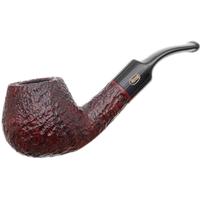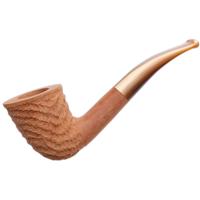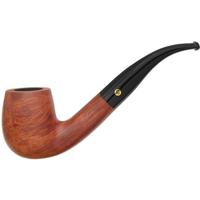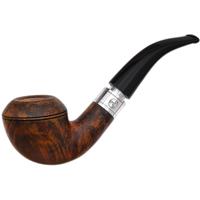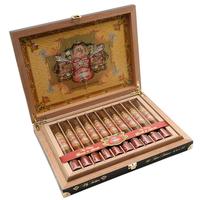I just got a jar of the Halcyon2 and Paragon pipe wax from fine pipes.
Let me say this. this is some good stuff no buffer needed. I would like to see what this stuff could do with a buffer. Heres the satas for each. Halycon 2 for sandblasted or rustacated pipes.
Our original product (Halcyon I) contained a formula that had been developed by technicians at the British Museum, and had won enthusiastic acceptance in the areas of antique furniture restoration and art conservation. Tested for 30 years in leading museums around the world, that formula was found to be superior in many ways to carnauba wax, and safer for the material on which it is applied. Moreover, it turned out to have a wide range of other uses in the home, studio and workshop. And because it could be applied in such small quantities, it was very economical.
The original Halcyon was well received by our customers. But after studying its formula, we found we could improve it in two significant ways for use by pipe smokers and collectors: first, we managed to find a blend of waxes that has a melting point that is 30 degrees higher than carnauba--nearly 200 degrees. This helps the wax to survive the heat of pipe smoking. Moreover, this new blend is harder and more durable than the old formula. Next, we found a carrier for the waxes that is quite expensive, but very highly refined, and less flammable than the older one. Best of all, has virtually no odor--less than .02% aromatic hydrocarbons. We are now blending, processing and packing this wax in-house. Halcyon II has shown itself to be notably superior in performance to Halcyon, while just as economical. It too can be used on woodwork, leather, violins and guitars, drill bits and fine machinery and many other materials--even computer screens.
Paragon wax for smooth pipes.
We developed Paragon in response to the feedback we received from our original Halcyon customers. They reported that while Halcyon gave a great finish on pipes and stems, carnauba applied with a buffing wheel provided a harder, longer lasting shine on smooth pipes. We began to investigate the physical chemistry of these waxes and soon realized why: carnauba is almost 9% harder than the waxes we were using in Halcyon II. Moreover, it is very viscous, so when applied on the wheel, it tends to fill in the tiny scratches and surface irregularities inevitably found on smooth surfaces, even after careful sanding and buffing.
So we began to develop a new blend, one that could be applied and polished by hand like Halcyon and had great temperature resistance, but provided a shine that was more brilliant and longer lasting than carnauba. We first discovered a "super" microcrystalline wax with very high molecular weight that was five times harder than carnauba, and had a melting point that was 100% higher. After much experimentation and blending with different solvents and natural waxes, we arrived at the current formulation for Paragon.
Its melting point is 228 degree F., 36% higher than carnauba alone and 11% higher than Halcyon II. It forms a thin, flexible yet tough coating on the surface of the wood, a coating that is nearly 30% harder than carnauba. Thus it resists abrasion from handling, repels moisture, and is far more effective in preventing oxidation, especially important for stems. It gives a deep, rich shine that is equal or superior to carnauba without a buffing wheel. It can be used on any smooth surface, including marble, steel, silver, ivory, meerschaum, glass, plastic, etc. However, because of its unusual hardness, it is not appropriate for leather or other textured materials, nor for sandblasted or rusticated pipes. For these, we continue to recommend Halcyon II.
Paragon is quite thick at room temperature, and should be applied with a soft cloth in small quantities. Shortly after application it will form a haze over the surface. At that point, it should be polished with a soft, lint free cloth (a microfiber polishing cloth is ideal but an old T-shirt works fine) to bring out a brilliant shine. Additional applications improve the shine and provide greater protection. A clean buffing wheel turning at slow speeds may be used as well, as long as it has not been used for any other wax, and is followed by hand polishing with a cloth.
I will say this the paragon wax I think is way better then carnauba wax I believe this with a buffing wheel would out do any factory shine done with carnauba wax. and at 5 bucks for a 1 oz jar of the Halcyon2 wax and 7 bucks for a oz jar of the Paragon wax how can one go wrong as it takes a little dab to do a pipe.
Let me say this. this is some good stuff no buffer needed. I would like to see what this stuff could do with a buffer. Heres the satas for each. Halycon 2 for sandblasted or rustacated pipes.
Our original product (Halcyon I) contained a formula that had been developed by technicians at the British Museum, and had won enthusiastic acceptance in the areas of antique furniture restoration and art conservation. Tested for 30 years in leading museums around the world, that formula was found to be superior in many ways to carnauba wax, and safer for the material on which it is applied. Moreover, it turned out to have a wide range of other uses in the home, studio and workshop. And because it could be applied in such small quantities, it was very economical.
The original Halcyon was well received by our customers. But after studying its formula, we found we could improve it in two significant ways for use by pipe smokers and collectors: first, we managed to find a blend of waxes that has a melting point that is 30 degrees higher than carnauba--nearly 200 degrees. This helps the wax to survive the heat of pipe smoking. Moreover, this new blend is harder and more durable than the old formula. Next, we found a carrier for the waxes that is quite expensive, but very highly refined, and less flammable than the older one. Best of all, has virtually no odor--less than .02% aromatic hydrocarbons. We are now blending, processing and packing this wax in-house. Halcyon II has shown itself to be notably superior in performance to Halcyon, while just as economical. It too can be used on woodwork, leather, violins and guitars, drill bits and fine machinery and many other materials--even computer screens.
Paragon wax for smooth pipes.
We developed Paragon in response to the feedback we received from our original Halcyon customers. They reported that while Halcyon gave a great finish on pipes and stems, carnauba applied with a buffing wheel provided a harder, longer lasting shine on smooth pipes. We began to investigate the physical chemistry of these waxes and soon realized why: carnauba is almost 9% harder than the waxes we were using in Halcyon II. Moreover, it is very viscous, so when applied on the wheel, it tends to fill in the tiny scratches and surface irregularities inevitably found on smooth surfaces, even after careful sanding and buffing.
So we began to develop a new blend, one that could be applied and polished by hand like Halcyon and had great temperature resistance, but provided a shine that was more brilliant and longer lasting than carnauba. We first discovered a "super" microcrystalline wax with very high molecular weight that was five times harder than carnauba, and had a melting point that was 100% higher. After much experimentation and blending with different solvents and natural waxes, we arrived at the current formulation for Paragon.
Its melting point is 228 degree F., 36% higher than carnauba alone and 11% higher than Halcyon II. It forms a thin, flexible yet tough coating on the surface of the wood, a coating that is nearly 30% harder than carnauba. Thus it resists abrasion from handling, repels moisture, and is far more effective in preventing oxidation, especially important for stems. It gives a deep, rich shine that is equal or superior to carnauba without a buffing wheel. It can be used on any smooth surface, including marble, steel, silver, ivory, meerschaum, glass, plastic, etc. However, because of its unusual hardness, it is not appropriate for leather or other textured materials, nor for sandblasted or rusticated pipes. For these, we continue to recommend Halcyon II.
Paragon is quite thick at room temperature, and should be applied with a soft cloth in small quantities. Shortly after application it will form a haze over the surface. At that point, it should be polished with a soft, lint free cloth (a microfiber polishing cloth is ideal but an old T-shirt works fine) to bring out a brilliant shine. Additional applications improve the shine and provide greater protection. A clean buffing wheel turning at slow speeds may be used as well, as long as it has not been used for any other wax, and is followed by hand polishing with a cloth.
I will say this the paragon wax I think is way better then carnauba wax I believe this with a buffing wheel would out do any factory shine done with carnauba wax. and at 5 bucks for a 1 oz jar of the Halcyon2 wax and 7 bucks for a oz jar of the Paragon wax how can one go wrong as it takes a little dab to do a pipe.



